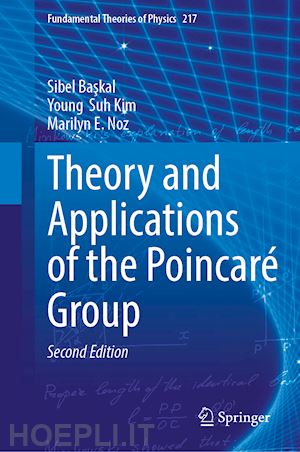
Questo prodotto usufruisce delle SPEDIZIONI GRATIS
selezionando l'opzione Corriere Veloce in fase di ordine.
Pagabile anche con Carta della cultura giovani e del merito, 18App Bonus Cultura e Carta del Docente
This book is intended mainly as a teaching tool directed toward those who desire a deeper understanding of group theory in terms of examples applicable to the physical world and/or of the physical world in terms of the symmetry properties which can best be formulated in terms of group theory. Both advanced students and scholars interested in the relationship between group theory and physics will find it instructive. In particular, those engaged in high-energy physics and foundations of quantum mechanics will find this book rich in illustrative examples of relativistic quantum mechanics.
This new edition contains four new chapters, two of which are consistent with Dirac's aim to combine the important developments in physics in the twentieth century, namely quantum mechanics and special relativity. Moreover, these new chapters also discuss various aspects of classical and quantum optics that are now understood to be interrelated. Most of the original chapters have been updated, either with new material added or in some instances reinterpretation of the original. The order of the chapters has been rearranged to create a more cohesive presentation. The original purpose of the first edition, namely to present examples to which physics students and researchers can relate, has not been altered.
Overview.- Theory of the Poincaré Group.- Theory of Spinors.- Group Contractions.- Covariant Harmonic Oscillator Formalism.- Dirac’s Form of Relativistic Quantum Mechanics.- Symmetries of Dirac’s Coupled Oscillators and Dirac’s Matrices.- The Lorentz Group.- Lorentz-Dirac Deformation in High-Energy Physics.- Decoherence and the Poincaré Sphere.-Lorentz Group in Classical Optics.
Young S. Kim came to the United States from South Korea in 1954 after high school graduation to become a freshman at the Carnegie Institute of Technology (now called Carnegie Mellon University) in Pittsburgh. In 1958, he went to Princeton University for graduate study in physics and received his PhD degree in 1961. In 1962, he became an assistant professor at the University of Maryland at College Park near Washington, DC. After going through the academic ranks of associate and full professors, Dr. Kim became a professor emeritus in 2007. This is still his position at the University of Maryland.
Dr. Kim’s thesis advisor at Princeton was Sam Treiman, but he had to go to Eugene Wigner whenever he had to face fundamental problems in physics. During this process, he became interested in Wigner’s 1939 paper on internal space-time symmetries particles in Einstein’s Lorentz-covariant world. Since 1973, his publications have been based primarily on constructing mathematical formulae for understanding Wigner’s paper. In 1988, Dr. Kim noted that the same set of mathematical devices are applicable to squeezed states in quantum optics. Since then, he has been publishing papers also on optical and information sciences. These days, Dr. Kim publishes articles on the question of whether quantum mechanics and special relativity can be derived from the same basket of equations.
Sibel Baskal is Professor Emerita of Physics at the Middle East Technical University. She is particularly interested in the manifestations of the Poincare´ and little groups, and of group contractions in physical sciences. Her research interests extend to current problems in classical field theories, mostly on alternative approaches to Einstein’s gravity. She has published more than 30 peer-reviewed papers and is the co-author of three books with Y.S.Kim and M.E.Noz.
Marilyn E. Noz is Professor Emerita in the Department of Radiology at NYU School of Medicine. Over the last more than 40 years, she has collaborated with Professor Kim on relativistic quantum mechanics using two-by-two matrices, harmonics oscillators, and the Lorentz group. She has contributed to over 50 peer-reviewed journal articles in elementary particle physics and optics. She has written three books with Professor Kim and three books with Professors Kim and Bas¸kal. She continues to do research in elementary particle physics and quantum optics. Professor Noz taught physics at Marymount College, Tarrytown, NY for five years, where she instituted a major in Physics. She then went to Indiana University of Pennsylvania where she taught physics for five years, rotating through most of the graduate and undergraduate courses. In 1974 she went to the New York University School of Medicine where she taught physics to radiology residents and students training to be ultrasound or nuclear medicine technologists. She has about one hundred refereed journal articles in medical related journals, where she used her physics background. Together with her co-author, Professor Gerald Q. Maguire Jr, she has published four books concerning radiation protection in the radiologic and health sciences.











Il sito utilizza cookie ed altri strumenti di tracciamento che raccolgono informazioni dal dispositivo dell’utente. Oltre ai cookie tecnici ed analitici aggregati, strettamente necessari per il funzionamento di questo sito web, previo consenso dell’utente possono essere installati cookie di profilazione e marketing e cookie dei social media. Cliccando su “Accetto tutti i cookie” saranno attivate tutte le categorie di cookie. Per accettare solo deterninate categorie di cookie, cliccare invece su “Impostazioni cookie”. Chiudendo il banner o continuando a navigare saranno installati solo cookie tecnici. Per maggiori dettagli, consultare la Cookie Policy.